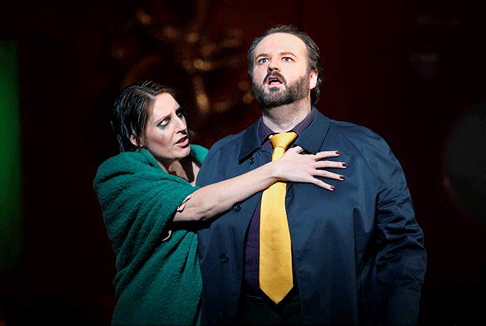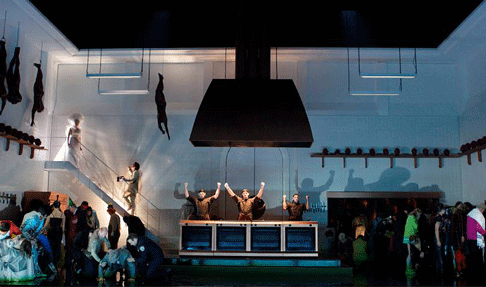13 Oct 2009
Turandot at ENO
A writer goes to dine in an urban Chinese restaurant, where his eye is caught by a distressed young woman among the crowd of diners.

A writer goes to dine in an urban Chinese restaurant, where his eye is caught by a distressed young woman among the crowd of diners.
He builds a bloody, Tarantino-esque fantasy plot around her and her surroundings, stepping in and manipulating the world he has created until the characters in his nightmarish scenario eventually become so real that they destroy not just the girl but the writer too.
The girl is Liù, the story Turandot, and the writer very likely Puccini himself (though no great effort is made to give actor Scott Handy the composer’s likeness). Puccini loved Liù as a character, and died after creating her death scene. Rupert Goold’s production ends with the dying writer (here, slashed through the stomach by Turandot’s sword just as Calaf overpowers her with a kiss) taking centre stage, while the triùmphantly united Calaf and Turandot are relegated to either side.
It wasn’t until an hour after the final curtain, when I sat down to draft this review after reading the programme notes in detail on my bus ride home, that the directorial conceit began to form a joined-up entity in my mind and I finally worked out — I think — what was supposed to be going on. While I was sitting in the Coliseum with it happening in front of me, it made no sense whatsoever, and that’s poor theatre by anybody’s standards. Turandot should be a garish nightmare, and this was — unfortunately, not always in the way the director intended. From the chorus, which looked as if it had been plucked from a generic modern-dress performance of Act 2 of La bohème (nuns, transsexuals, Elvis impersonators, dominatrices…), to the murderous dancers with chefs’ trousers and pigs’ heads, to the Emperor Altoum (eloquently sung by Stuart Kale) who was played as an eccentric old drunk that the ‘writer’ decides to use as a pawn in his story, to Turandot’s creepy little servant-girl (or familiar spirit?) in her First Communion outfit — none of it bore any relation either to the plot or to Puccini’s music.
Kirsten Blanck’s soft-grained voice and dry European consonants take away any real cutting edge from her soprano, but she has a voice that is more than adequate for such a big role in such a big theatre, and rides the Act 2 ensemble very effectively. It’s just a shame that her character is given no dramatic context whatever. In the first act, Calaf falls in love not with the real Turandot but with a giant ice-sculpture facsimile of her; from her first appearance ‘in the flesh’ in Act 2, she looks like a demented bride.
The vocal highlights of this production come from Gwyn Hughes Jones as Calaf and Amanda Echalaz as Liù. Hughes Jones sings gloriously, even if he sounds underpowered once the heavy orchestration of the Alfano ending is underway. Not a natural stage creature, he fails to create much of a character — like Blanck, he has next to no help from the director in doing so. Just why, exactly, does he fall instantly in love? And what is it about him that eventually melts the ice princess? He has vocal ardour in spades, but his physical presence is oddly dispassionate. As for Echalaz — after a few years of spectacular performances for smaller UK companies like ETO and Opera Holland Park, the South African soprano’s star is at last truly in the ascendant. It is a large voice and there is some work she could still do on some of the more delicate parts of the role, but she has a magnetic stage presence and (despite a truly horrible costume) gave a performance of real heart. The American bass James Cresswell was a sincerely sung, sympathetic Timur.
 Amanda Echalaz as Liù and Gwyn Hughes Jones as Calaf
Amanda Echalaz as Liù and Gwyn Hughes Jones as Calaf
In the pit, Ed Gardner is on top form, making the lyrical passages bloom and the brutal ones blaze, while the ENO Chorus produce a massive and impressive sound. Most of William Radice’s translation is pretty respectable, but there are a few obvious problems which really need to be ironed out: in one of the opera’s subtlest and most legato passages, the moon chorus in Act 1, the words are perversely set against the beat, while in Act 3 the principals are subjected to rather a lot of unkind ‘i’ and ‘ee’ vowels on climactic high notes. And Pang’s nostalgia for his ‘gardens near Kiù’ was always destined to raise an unintentional titter from a London audience.
 Full Stage
Full Stage
The trio of ministers was plagued by illness; Peter van Hulle replaced Christopher Turner as Pong, while Richard Roberts (announced as suffering from a throat infection but willing to sing anyway) croaked his way through the first act before yielding to understudy Gareth Huw John (singing from the side of the stage) for the rest of the opera. Fortunately Benedict Nelson, the Ping, was not only completely healthy but in particularly fine voice.
Turandot was really the last of the great repertoire standards to get an up-to-date production in London. It is not the nightmare-Chinese-restaurant setting (with sets imaginatively conceived by Miriam Buether) that ruins Goold’s vision of the opera but his willingness to allow many of the opera’s big climaxes to take second place to the point he wants to make about the composer’s relationship with the piece. As such, it is a frustrating experience.
Ruth Elleson © 2009